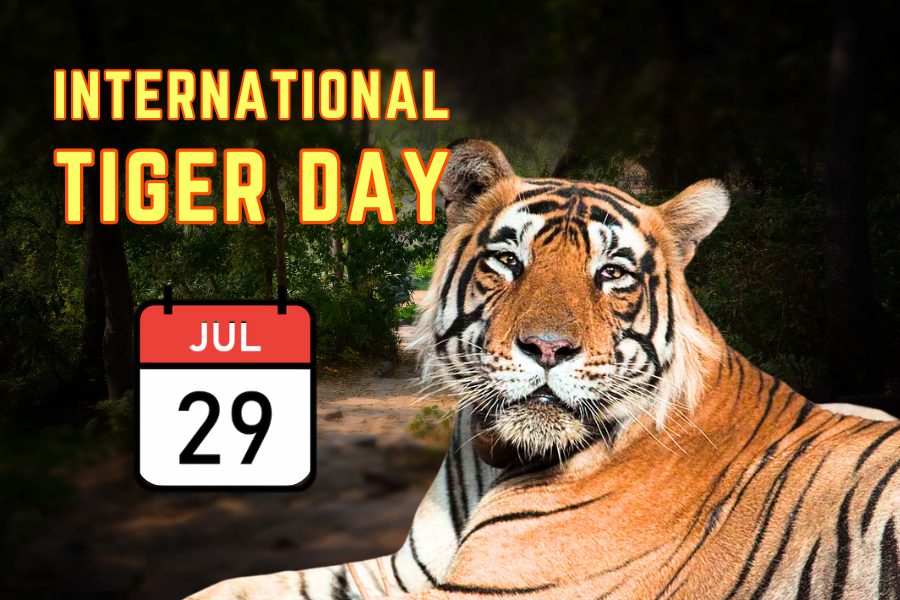(Mohsin Tanvir)
29 July, International Tiger Day galvanises the world, uniting nations, communities, and conservationists to protect the majestic tiger, an endangered icon of biodiversity. In 2025, falling on a Tuesday, this observance rallies millions to combat the dire threats of poaching, habitat loss, and human-wildlife conflict. Established in 2010 at the Saint Petersburg Tiger Summit, the day set an ambitious goal to double wild tiger numbers by 2022. Although only 5,574 tigers remain, with India leading at 3,682, progress continues. The 2025 theme, “Their Future in Our Hands,” underscores the urgent need to secure tigers’ survival, ensuring vibrant ecosystems for future generations. This article explores the day’s history, significance, and actionable steps to champion this noble cause.
HISTORY: A GLOBAL PLEDGE FOR TIGERS
In 2010, the Saint Petersburg Tiger Summit in Russia birthed Global Tiger Day, uniting 13 tiger-range countries—India, Bangladesh, Nepal, Bhutan, Russia, China, Thailand, Indonesia, Malaysia, Myanmar, Laos, Cambodia, and Vietnam. They pledged the “Tx2” goal: doubling the wild tiger population from 3,200 to 6,400 by 2022. Spearheaded by the Global Tiger Initiative and backed by leaders like Vladimir Putin, the summit introduced stringent anti-poaching laws and habitat protections. Since then, 29 July has sparked global campaigns, festivals, and educational events. Although the Tx2 target fell short, tiger numbers rose 74% to 5,574 by 2025, reflecting collective resolve. Notably, these efforts continue to inspire conservation worldwide.
SIGNIFICANCE: TIGERS AS ECOSYSTEM GUARDIANS
Tigers, the largest wild cats, are keystone species vital to ecosystem health. Furthermore, they regulate prey populations like deer and boar, preventing overgrazing and ensuring forest regeneration. Their presence signals robust biodiversity, supporting carbon storage and climate stability. However, with over 95% of their historic range lost, only 5,574 tigers survive in fragmented habitats. Global Tiger Day highlights these stakes, urging governments, NGOs, and communities to act. The 2025 theme, “Their Future in Our Hands,” emphasises human responsibility, calling for anti-poaching measures, habitat restoration, and community engagement. Consequently, saving tigers preserves entire ecosystems, safeguarding nature’s balance for all species.
THREATS TO TIGERS: A LOOMING CRISIS
Tigers face relentless threats: poaching, habitat destruction, human-wildlife conflict, and climate change. Historically, their population plummeted from 100,000 to under 4,000 by 2010, with three subspecies extinct. Consequently, poaching for bones, skins, and body parts fuels illegal trade, while habitat loss—down to 1 million km² from 11 million—fragments corridors. In regions like the Sundarbans, rising sea levels exacerbate conflicts, pushing tigers into human settlements. Meanwhile, India, hosting 75% of global tigers, battles high human density, with 60 million people sharing 138,200 km² of tiger habitat. These challenges demand urgent action, as localized extinctions threaten biodiversity. Global Tiger Day 2025 amplifies this crisis, rallying support to halt the decline.
CONSERVATION SUCCESSES: A RAY OF HOPE
Despite challenges, conservation yields gains. For instance, India’s Project Tiger, launched in 1973, boosted numbers from 1,706 in 2010 to 3,682 in 2022, with 58 reserves like Nagarjunsagar-Srisailam (3,296 km²) leading efforts. Nepal’s 2022 census reported 235 tigers, driven by protected areas. Similarly, Russia’s Amur tiger population grew, thanks to Putin’s stringent laws and the Amur Tiger Centre’s anti-poaching patrols. Bhutan and Bangladesh also report progress through community initiatives. Although the Tx2 goal was unmet, a 74% global increase to 5,574 tigers by 2025 showcases success. Stories like the rescue of tigress Zeenat across three Indian states highlight local dedication. Global Tiger Day celebrates these victories, inspiring further action.
INDIA’S PIVOTAL ROLE
Leading globally, India anchors tiger conservation, hosting 75% of the world’s 5,574 wild tigers. Launched in 1973, Project Tiger expanded to 58 reserves, with Dholpur-Karauli notified in 2023. The 2022 census recorded 3,682 tigers, doubling from 2010, driven by robust monitoring and anti-poaching patrols. Prime Minister Narendra Modi hailed this as a “proud moment” in 2023, noting India’s 75% tiger share in its 75th independence year. However, challenges like human density and habitat fragmentation persist. This approach of protected areas and community engagement inspires nations like Nepal and Bhutan. On Global Tiger Day 2025, India’s events at reserves like Corbett will urge global emulation of its science-based strategies.
INTERNATIONAL PARTICIPATION: A WORLDWIDE MOVEMENT
Across the globe, Global Tiger Day unites tiger-range and non-range countries. In 2025, events include Dartmoor Zoo’s fundraiser with keeper talks, WWF’s “Orange Your World” social media campaign, and Nepal’s Chitwan workshops. Non-range nations like the U.K. and U.S. host zoo events, exhibitions, and school programmes. Celebrities amplify campaigns, some removing social media profile photos to symbolise tigers’ fading presence. Moreover, educational initiatives like online quizzes and tiger-themed crafts engage youth, while responsible tourism fosters sustainable economies. Social media hashtags—#InternationalTigerDay, #SaveTigers—drive awareness, with WWF and the Global Tiger Forum leading efforts. Thus, these initiatives ensure tigers’ survival resonates globally.
ACTIONABLE STEPS FOR 2025
Global Tiger Day 2025 offers practical ways to contribute. Individuals can donate to charities like WWF or WildCats Conservation Alliance, funding anti-poaching and habitat restoration. Sharing facts—e.g., tigers’ unique stripes or 2-km roars—spreads awareness online. Communities can organise tree-planting drives, awareness booths, or school debates on tiger ecology. Furthermore, responsible tourism, avoiding exploitative wildlife practices, supports local stewardship. Educators can host workshops, while students create posters or essays. Adopting a tiger through WWF funds ranger patrols. Governments must strengthen habitat corridors and anti-poaching laws, as urged by the 2025 theme, “Their Future in Our Hands.” Every action helps secure tigers’ future.
FUTURE OUTLOOK: A CALL TO ENDURE
Looking ahead, the fight to save tigers remains urgent. While the Tx2 goal fell short, the 74% rise to 5,574 tigers by 2025 proves conservation works. Yet, with only 1 million km² of habitat left and poaching persistent, complacency is dangerous. Global Tiger Day 2025 will push for stronger habitat connectivity, community-led efforts, and global cooperation. India’s success, alongside Nepal and Russia, offers a blueprint, but climate change and human encroachment demand sustained action. By rallying governments, NGOs, and individuals, the day ensures tigers remain guardians of biodiversity. Their survival depends on our unwavering commitment.
CONCLUSION: OUR SHARED RESPONSIBILITY
On 29 July 2025, Global Tiger Day calls humanity to save tigers from extinction. With 5,574 left, their survival hinges on combating poaching, restoring habitats, and fostering coexistence. India’s leadership, with 3,682 tigers, inspires hope, but global unity is essential. The theme “Their Future in Our Hands” reminds us that every donation, post, or policy shapes their fate. Let us honour these striped guardians, ensuring their roars echo in thriving forests. Together, we can preserve biodiversity and a planet where tigers roam free.







